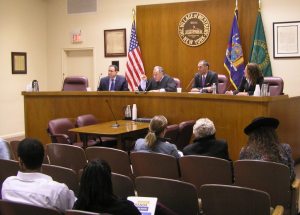Martin Tankleff, who was convicted of murdering his parents in 1990 and spent 17 years in jail for the offense, was the featured speaker at the third annual Law Day program at Village Justice Court on Thursday, April 28. Tankleff along with two other panelists, St. John’s Law School Dean, Michael Simons and attorney Erica Dubno, shared their views on the evenings theme, Miranda: More Than Words. Village Justice Thomas Liotti introduced the speakers and gave some insight on the topic of Miranda Rights.
“I am excited to talk about this year’s Law Day theme as chosen by the American Bar Association, Miranda; More Than Words,” said Liotti. “It is a topic truly profound in its meaning for us in this important presidential year. The Miranda vs. Arizona case which ultimately formed the basis for Miranda Rights helped in our fifth amendment rights against self incrimination and also became part of our common law.”

Tankleff, who was released from his sentence in 2007 and is now studying to be an attorney, focused his topic on false confessions and wrongfully convicted defendants.
“In a lot of criminal cases, innocent suspects believe as their case goes on their innocence will be proved but this is not usually the case,” said Tankleff. “Once law enforcement has any sort of confession from a suspect, coerced or not, they are done with the case.”
Tankleff referenced his own case in which he was forced into an interrogation room and subjected to physical and psychological abuse in order to obtain a confession of guilt.
“They utilized every means of interrogation on me,” he said. “From food, light and sensory deprivation to telling me that fake evidence existed against me. Law enforcement looked to get incriminating statements in that room by any means necessary.”
Tankleff said at the time of his conviction there was no video or audio evidence to prove his innocence and that DNA and forensic testing and analysis was in its infant stage.
“Basically my case was a he said, she said type of thing and the linchpin of the case came down to the falsified confession that was obtained,” said Tankleff. “So does the Miranda protect innocent people? Probably not. There are a lot of innocent people who wrongly confess to crimes they didn’t commit and a lot of guilty people who remain free.”
Dubno, a criminal defense lawyer, spoke about the eighth amendment in regards to an individual’s Miranda rights.

“How does cruel and unusual punishment and torture and coercion on defendants to obtain information violate one’s constitutional rights? Are they safeguarded or sacrificed?” said Dubno.
She gave two examples of violations of constitutional rights—in the Salem Massacre of 1692 and the Central Park jogger case in 1989.
“In Salem, Massachusetts in 1692, people who were suspected of witchcraft were tortured to obtain information. Nineteen innocent people were hanged because fear drove those coercions,” said Dubno. “Again in 1989, five young black and Spanish teenagers were tortured by having to spend up to 72 hours in an interrogation room for a crime they did not commit. All five defendants eventually confessed to some aspect of the brutal rape of the jogger and all served time in prison. They were ultimately exonerated.”
Dubno stated an interesting fact that 80 percent of people who were given their Miranda rights by law enforcement, ended up speaking to the police anyway.
“Why do they do it? Because people have this fear of being guilty when being probed by the police or looking guilty when asking for their lawyer,” she said. “People yelling in their faces, the bright lights on them and the food and sensory deprivation ultimately takes its toll.”
Simons spoke about how the Miranda Rights came about and the importance of the fifth and sixth amendments.
“The fifth amendment which protects against self-incrimination and the sixth amendment which allows suspects to retain legal counsel, are some of the most important ones we have in the judicial system,” said Simon. “These amendments helped give rise to the Miranda Rights.”































